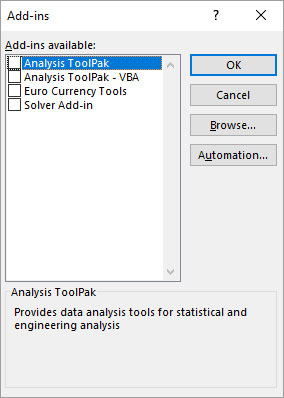
Recover Permanently Deleted or Erased Excel 2007 Files for Free | Stellar

How to Repair Multiple Excel Files by Using Stellar
With Stellar Repair for Excel, it is quite easy and simple to repair multiple MS Excel (XLS and XLSX) files that are damaged. This is because the software has a self-explanatory interface and hence is a Do-it-yourself software. Nonetheless, when using this software to repair multiple Excel files, you would have to add all of the files into the software by following a few pre-defined steps. Follow the steps mentioned below:
- Launch Stellar Repair for Excel software.
- Under Home menu, click Select file
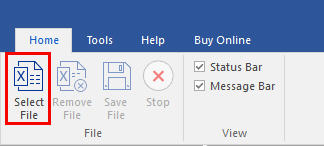
- Click Browse and select corrupt Excel files. Select the checkbox to repair multiple files.
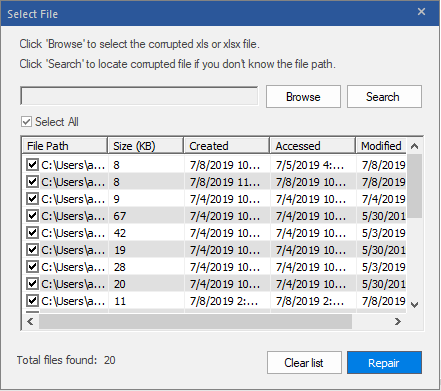
- Click Repair
- The software provides the preview facility. You can check the it on left pane.
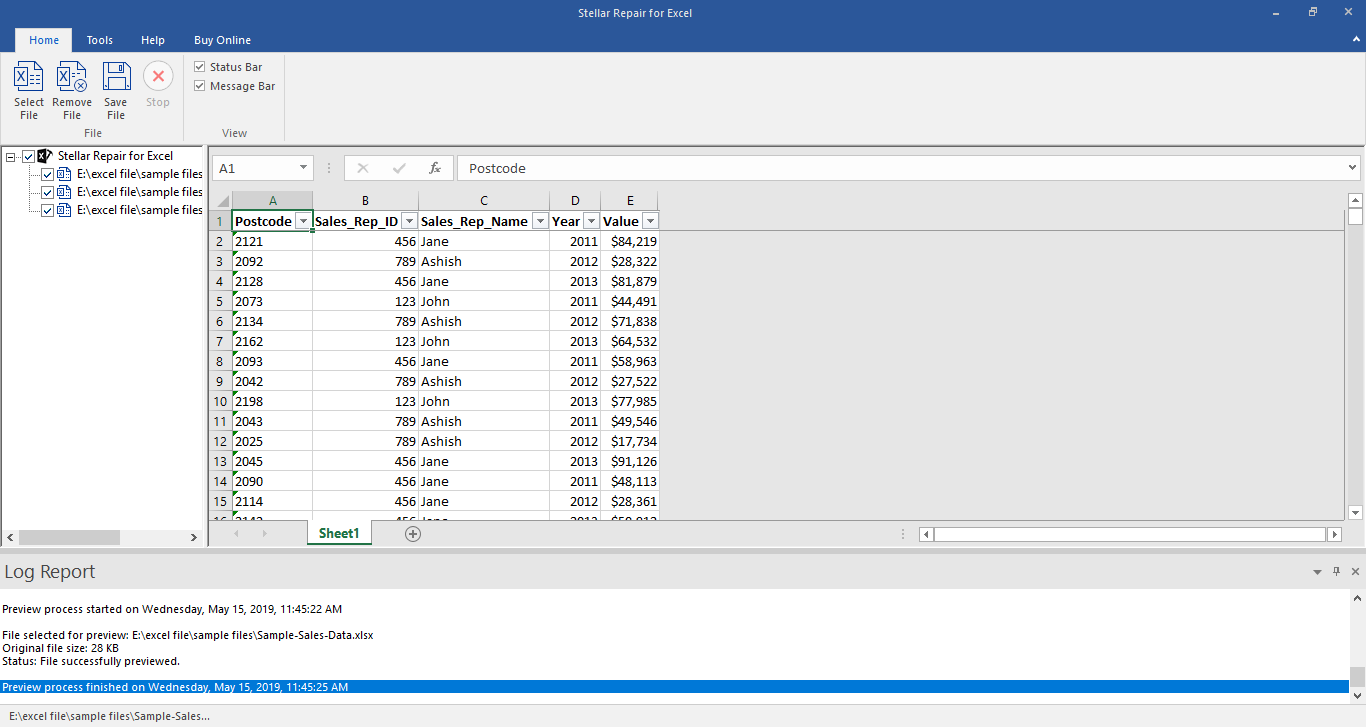
- Save the repired filr ether Default location or Select New Folder radio button.
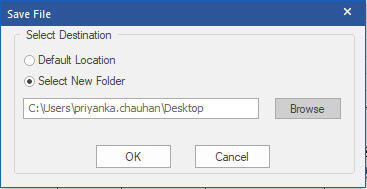
Stellar Repair for Excel Stellar Repair for Excel is the best choice for repairing corrupt or damaged Excel (.XLS/.XLSX) files. This Excel recovery software restores everything from corrupt file to a new blank Excel file.
[Fixed] Excel Cannot Open the File Because the File Format or File Extension Is Not Valid
When opening an older version of an Excel file in a newer version, you may encounter the “Excel cannot open the file because the extension is not valid” error. This happens if you have accidentally renamed the file with a different file format or an incorrect file extension. Also, you may get the ‘Excel cannot open the file’ error if the file has become unreadable or corrupted.
This is how the complete Excel error message looks like:
“Excel cannot open the file filename.xlsx because the file format or file extension is not valid. Verify that the file has not been corrupted and that the file extension matches the format of the file.”

Check out this video for a quick demonstration of how to fix “Excel Cannot Open the File Because the File Format or File Extension Is Not Valid”
How to Fix the ‘Excel Cannot Open the File Because the File Format or Extension Is Not Valid’ Error?
Try any of these workarounds to fix the error and regain access to your Excel file data:
Workaround 1 – Change the Default File Format
By default, an Excel file is saved in .xlsx or .xls file format. Trying to open the file with a different or incorrect extension may cause the ‘Excel cannot open the file because the extension is not valid’ error. To fix the error, try changing the Excel default file format by following these steps:
Note: Take a backup of the Excel file that you cannot open and try the steps on the backup copy.
- In Excel 2010 and newer versions, click on the File menu.
Note: For Excel 2007 and earlier versions, click on the Office button.
- On the left panel, click on Options.
- In ‘Excel Options’ window, under Save workbooks section, click on the Save files in this file format: drop-down. Select a file format (i.e., the one supported by your Excel version).
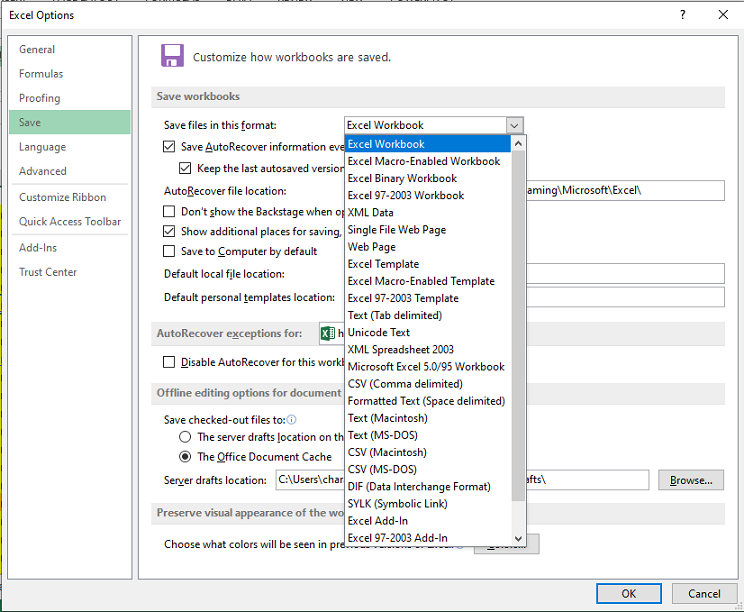
- Click OK.
Check if you can open your Excel file. If not, try the next workaround.
Workaround 2 – Edit the Excel File Permissions
You may receive the ‘Excel file format or file extension is not valid’ error if you lack sufficient permissions to open the file. Usually this happens when you try to open an Excel file received from some other user. Follow these steps to change the file permissions and see if it fixes the problem:
- Right-click on the file that won’t open and click Properties.
- In the file properties dialog box, click the Security tab and then hit the Edit button.
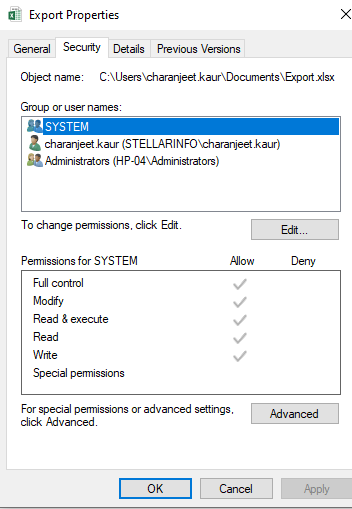
- When the file’s permissions dialog box appears, click on the Add button.
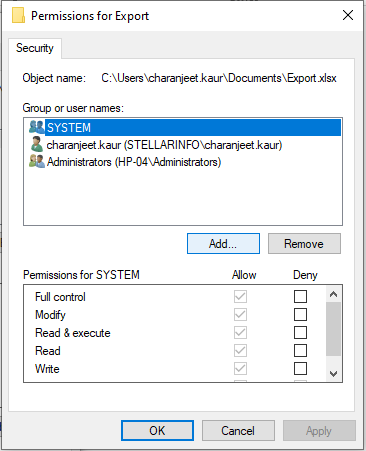
- Click on the Advanced button from the ‘Select Users or Groups’ window.
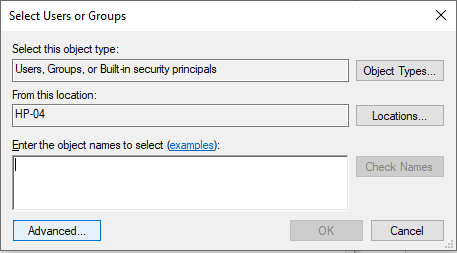
- Select Find Now. A list of all users and groups will get displayed in a search results box. Choose Everyone group from the list and hit OK.
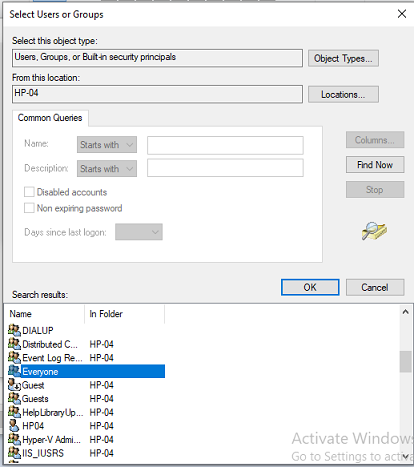
- You can see the ‘Everyone’ group in the ‘Enter the object names to select’ textbox. Click OK once again to return to the file’s permission dialog box.
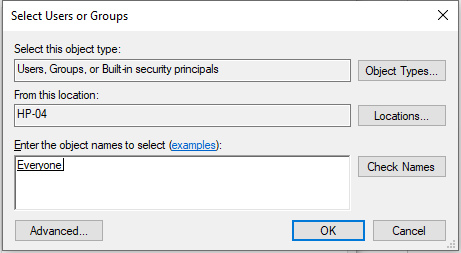
- Click Everyone from the Group or user names: box and check all the checkboxes under Allow.
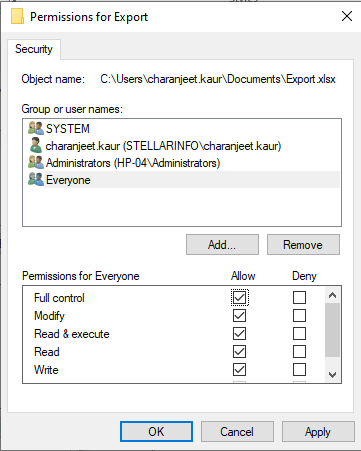
- Click on Apply and then OK.
Now try to open the Excel file. If you’re still getting the Excel file cannot open error, use the following workaround.
Workaround 3 – Recover Unsaved Workbook
If the ‘Excel file extension not valid error’ occurs when attempting to open an unsaved workbook, do the following to recover the unsaved workbook:
- In Excel, click File.
- From the Info screen, under Manage Versions, click Recover Unsaved Workbooks.
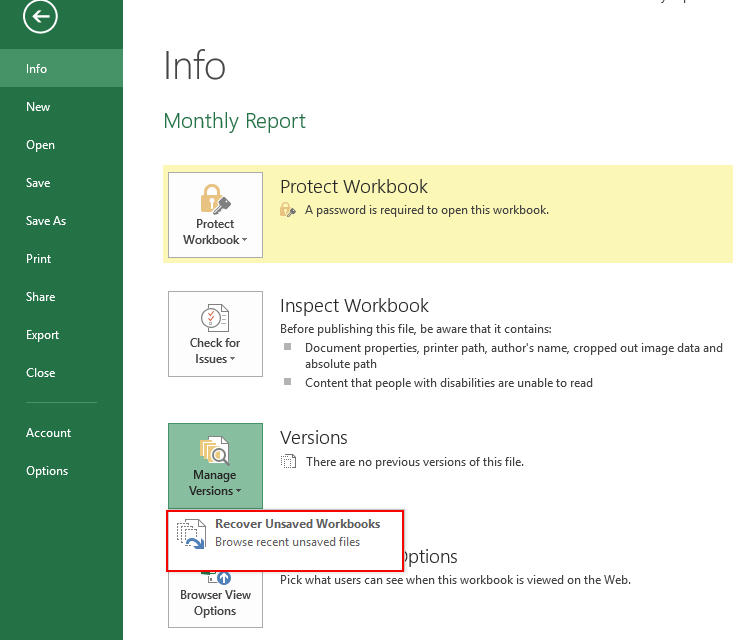
Excel will list any unsaved files. Try opening the file and save it. If this doesn’t work, skip to the next workaround.
Workaround 4 – Repair the Workbook
If none of the above workarounds has worked for you, chances are that the Excel file has become corrupted. Try to repair the file using the Excel inbuilt ‘Open and Repair’ utility by following these steps:
- In your Excel application, click on File > Open.
- In the ‘Open’ dialog box that pops-up, select the Excel file you want to repair and click the arrow next to the Open button.
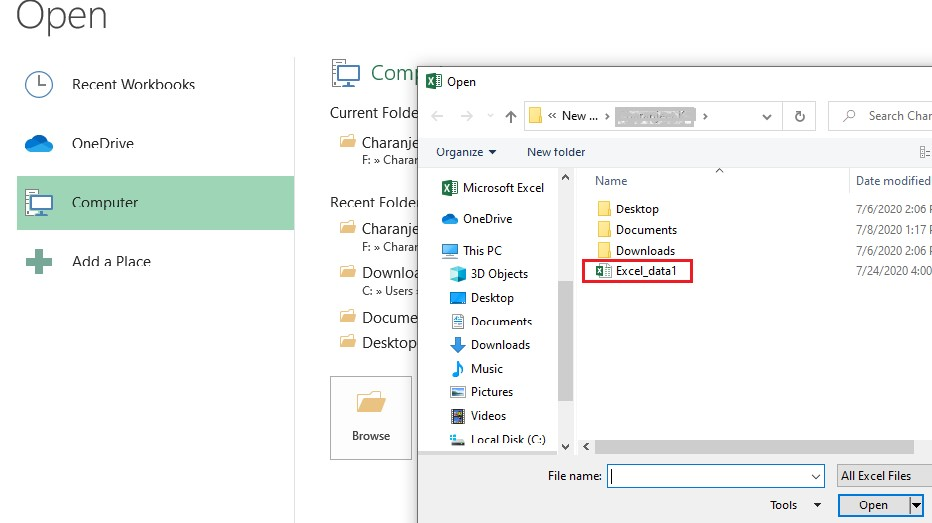
- From the dropdown list, select Open and Repair.
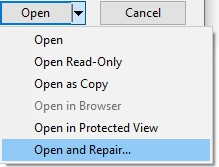
- Excel will ask you to attempt to repair the file or extract data from it. Click Repair to retrieve maximum data. If the Repair option fails, click on Extract Data to recover the data without formulas and values.

If the ‘Open and Repair’ utility doesn’t help fix the corrupted file and/or recover the data, use an Excel repair tool such as Stellar Repair for Excel to regain access to your file and its data.
Stellar Repair for Excel software can help repair severely corrupted XLS and XLSX files. Also, it helps recover all the file components, including tables, pivot tables, cell comments, charts, chart sheets, images, formulas, etc., without impacting the original structure of the Excel file.
To learn how the software works, read this: How to repair corrupt Excel file using Stellar Repair for Excel?
Conclusion
You may encounter the error ‘Excel cannot open the file because the extension is not valid’ when opening a workbook with a different file format or an incorrect file extension. Also, the error may occur if the Excel file has turned corrupt. This article has covered some of the most effective workarounds to resolve the error. But if nothing works, you can try to repair the Excel file and retrieve its data using the Stellar Repair for Excel software.
Solved - The File is Corrupted and Cannot be Opened - Excel
Summary: Unable to open Excel file due to the error ‘The file is corrupted and cannot be opened’? Read this blog to find more details about the error, possible reasons behind it, and solutions to fix the error. In addition, the blog mentions about Stellar Repair for Excel software that can help fix the Excel error in a few clicks. Download the software now and see free preview of the file.
About the Error
Microsoft Excel is a widely used spreadsheet application that comes bundled with MS Office. Users tend to update the application with new security patches and features. Sometimes these updates can cause problems, and result in “The file is corrupted and cannot be opened” error.

Figure 1 – Excel File Corrupted Error Message
Other Possible Reasons behind ‘The File is Corrupt and Cannot Be Opened’ Excel Error
- Opening an older Excel version file in a newer version of Excel. For instance, opening Excel 2013, 2010, or earlier versions in Excel 2016.
- When attempting to open a Microsoft Office (Excel) email attachment in Microsoft Outlook 2010, MS Office 2010 reports a problem with the file preventing it from opening.
How to Fix the ‘Excel File is Corrupt and Cannot Be Opened’ Error?
Here are a few possible solutions that you can try to fix the ‘Excel file is corrupt and cannot be opened’ issue and open your Excel file.
Solution 1: Changing Component Services Settings
Solution 2: Changing the Protected View Settings
Solution 3: Repair Excel Files using Excel Repair Software
Solution 1: Changing Component Services Settings
[Caution] Changing Component Services settings requires making changes to the registry, and any mistake can harm your computer.
Follow these steps to change ‘Component Services’ settings:
Click ‘Start’ or ‘Win+R’ and type ‘dcomcnfg’ and press ‘Enter’.
In the navigation pane, expand the ‘Component Services’, and then expand ‘Computers’.

Figure 2 – Component Services Settings
- Next, right-click on ‘My Computer’, and then click ‘Properties’.
When the ‘My Computer Properties’ dialog box appears, click on the ‘Default Properties’ tab and then set the following values:
- Default Authentication Level: Connect
- Default Impersonation Level: Identify

Figure 3 – Illustrates My Computer Properties
- Click ‘OK’ to change ‘Default Properties’
Solution 2: Changing the Protected View Settings
[Caution] Disabling the ‘Protected View’ can put your system at high risk. Viruses attached to the Excel files can attack and infect your system. Be careful before using this option.
Excel 2010 file cannot open due to the ‘Protected View’ setting in Microsoft Outlook 2010. And so, changing the setting may help fix the error. For this, perform these steps:
- Open MS Excel 2010, go to the ‘File’ menu and click ‘Options’.

Figure 4 – Options
- When the ‘Excel Options’ window opens, click on ‘Trust Center’ and then on ‘Trust Center Settings’.

Figure 5 – Open Trust Center Settings
- Next, choose ‘Protected View’ and uncheck all the options including ‘Enable Protected View for Outlook attachments’ if you use Outlook for email.

Figure 6 – Uncheck Protected View Settings
- Click ‘OK’. Restart the application and try opening the Excel file again.
If none of the above solutions works for you, your Excel file is likely severely corrupt. To repair corrupt Excel files, you need to use advanced options like Stellar Repair for Excel tool. It repairs corrupt and damaged Excel files and helps in retrieving lost data.
Solution 3: Use Excel File Repair Tool
Considering the risks associated with the above solutions, it’s better to use an Excel repair tool to repair single or multiple corrupt Excel files at once. The process is simple, and even a novice can use the Excel file repair tool to repair Excel files with the help of the following steps:
- Download Stellar Repair for Excel and install it.
- Launch the tool. In the tool’s main interface, click ‘Browse’ to select the file. If you don’t know the file location use the ‘Search’ option.

Figure 7 – Illustrates Selecting Corrupt Excel File in Stellar Repair for Excel
- Select the file, and then click on Repair.

Figure 8 – Illustrates Initiating Excel File Repair in Stellar Repair for Excel
- The software scans and lists the Excel file in the left pane. Click on the file to preview its recoverable objects in the right pane.

Figure 9 – Illustrates Preview of Recoverable Excel File Objects
- Save the repaired file at either the default location or a user-specified location.

Figure 10 – Illustrates Saving Repaired Excel File in Stellar Repair for Excel
- Click ‘OK’ to save the repaired Excel file. After the repair process is completed, browse to the location and open it with MS Excel 2010 or any other version.

Figure 11 – Illustrates Saving Complete Message in Stellar Repair for Excel
You will be able to access your Excel file from the selected location.
Conclusion
You can use the first two possible solutions to fix the “The file is corrupted and cannot be opened” error. If you can access the file, save its data and restore the default settings. However, if the file is corrupt and the data retrieved using the first two solutions is inconsistent or incomplete, use Stellar Repair for Excel. This tool can help you recover Tables, Charts, Chart Sheets, cell comments, Images, and Formulas while preserving the worksheet properties and cell formatting. You can also preview the file and verify the data inside the file before saving it.
How Can I Recover Corrupted Excel File 2016?
Error Messages Indicating Corruption in Excel File
- When an Excel 2016 file turns corrupt, you’ll receive an error message that reads: “The file is corrupt and cannot be opened .”
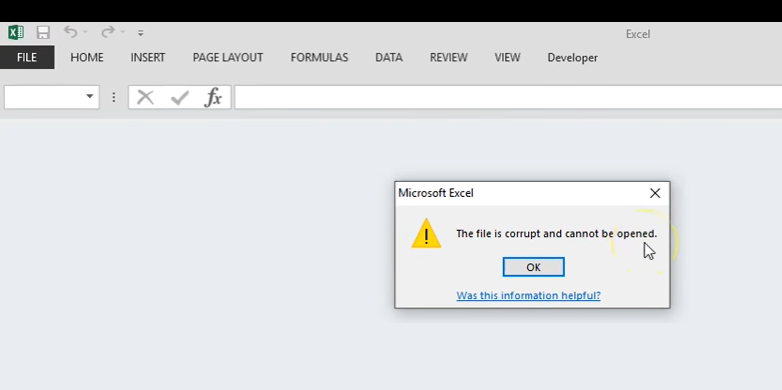
- But sometimes, you encounter the “Excel cannot open this file” error message due to corruption in the file.
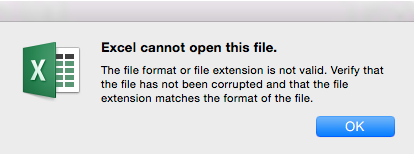
Why does Excel File turn Corrupt?
Following are some common reasons that can turn an Excel file corrupt:
- Large size of the Excel file
- The file is virus infected
- Hard drive on which Excel file is stored has developed bad sectors
- Abrupt system shutdown while working on a worksheet
Workarounds to Recover Data from Corrupt Excel
The workarounds to recover corrupted Excel file 2016 data will vary depending on whether you can open the file or not.
How to Recover Corrupted Excel File 2016 Data When You Can Open the File?
If the corrupt Excel file is open, try any of the following workarounds to retrieve the data:
Workaround 1 – Use the Recover Unsaved Workbooks Option
If your Excel file gets corrupt while you are working on it and you haven’t saved the changes, you can try retrieving the file’s data by following these steps:
- Open your Excel 2016 application and click on the Open Other Workbooks option.

- Click the Recover Unsaved Workbooks button at the bottom of the ‘Recent Workbooks’ section.
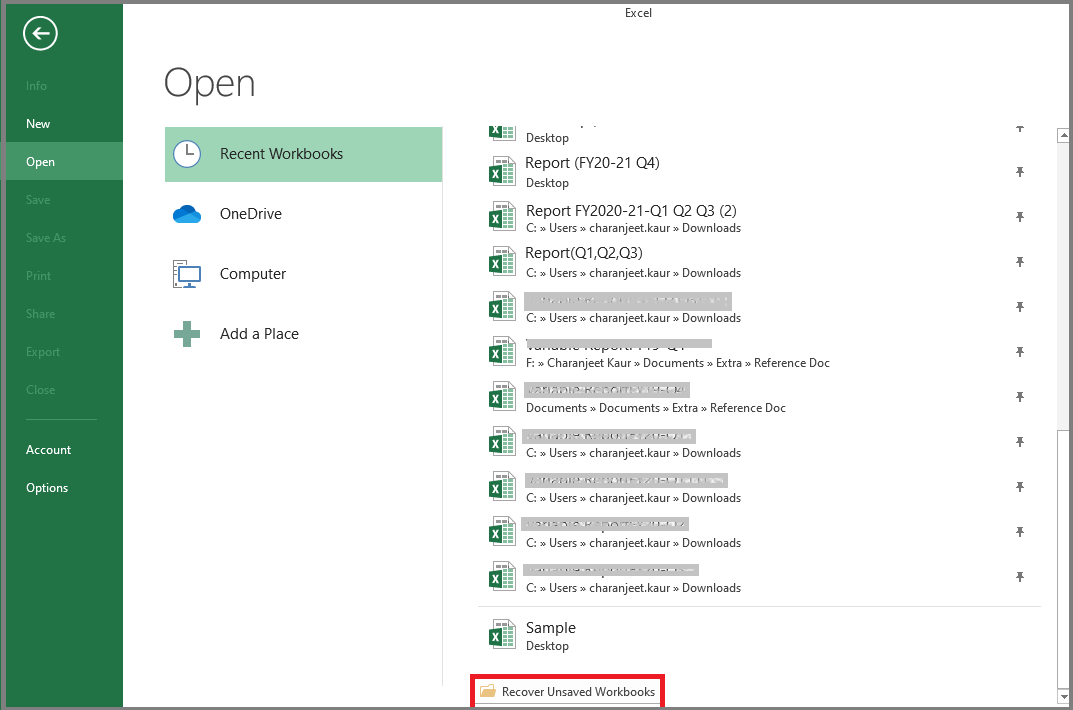
- A window with list of unsaved Excel files will open. Click the corrupt file you want to open.
This will reopen your last saved version of the Excel workbook. If this method doesn’t work, proceed with the next workaround.
Workaround 2 – Revert to Last Saved Version of your Excel File
If your Excel file gets corrupt in the middle of making any changes, you can recover the file’s data if the changes haven’t been saved. For this, you need to revert to the last saved version of your Excel file. Doing so will discard any changes that may have caused the file to turn corrupt. Here’s how to do it:
- In your Excel 2016 file, click File from the main menu.
- Click Open. From the list of workbooks under Recent workbooks, double-click the corrupt workbook that is already open in Excel.
- Click Yes when prompted to reopen the workbook.
Excel will revert the corrupt file to its last saved version. If it fails, skip to the next workaround.
Workaround 3 – Save the Corrupted Excel File in Symbolic Link (SYLK) Format
Saving an Excel file in SYLK format might help you filter out corrupted elements from the file. Here are the steps to do so:
- From your Excel File menu, choose Save As.
- In ‘Save As’ window that pops-up, from the Save as type dropdown list, choose the SYLK (Symbolic Link) option, and then click Save.
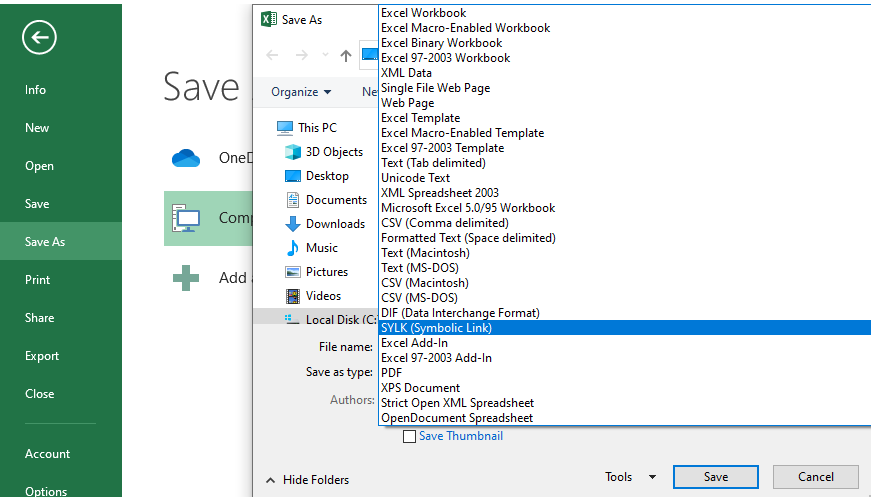
Note: Only the active sheet will be saved in workbook on choosing the SYLK format.
- Click OK when prompted that “The selected file type does not support workbooks that contain multiple sheets”. This will only save the active sheet.

- Click Yes when the warning message appears - “Some features in your workbook might be lost if you save it as SYLK (Symbolic Link)”.

- Click File > Open.
- Browse the corrupt workbook saved with SYLK format (.slk) and open it.
- After opening the file, select File > Save As.
- In ‘Save as type’ dialog box, select Excel workbook.
- Rename the workbook and hit the Save button.
After performing these steps, a copy of your original workbook will be saved at the specified location.
How to Recover Corrupted Excel File 2016 Data When You Cannot Open the File?
If you can’t access the Excel file, apply one of these workarounds to salvage the file’s data.
Workaround 1 – Open and Repair the Excel File
Excel automatically initiates ‘File Recovery’ mode on opening a corrupt file. After starting the auto-recovery mode, it attempts to reopen and repair the corrupt Excel file at the same time. If the auto-recovery mode does not start automatically, you can try to fix corrupted Excel file 2016 manually by using ‘Open and Repair’. Follow these steps:
- Open a blank file, click the File tab and select Open.
- Browse the location where the corrupt 2016 Excel file is stored.
- When an ‘Open’ dialog box appears, select the file you want to repair.
- Once the file is selected, click the arrow next to the Open button, and then click the Open and Repair button.
- Do any of these actions:
- Click Repair to fix corrupted file and recover data from it.
- Click Extract Data if you cannot repair the file or only need to extract values and formulas.

If performing these actions doesn’t help you retrieve the data, proceed with the next workaround.
Workaround 2 – Disable the Protected View Settings
Follow these steps to disable the protected view settings in an Excel file:
- Open a blank 2016 workbook.

- Click the File tab and then select Options.
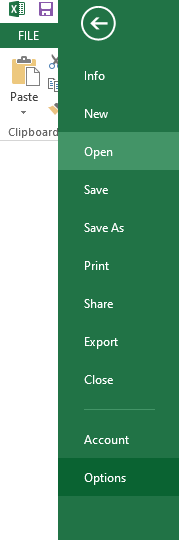
- When an Excel Options window opens, click Trust Center > Trust Center Settings.
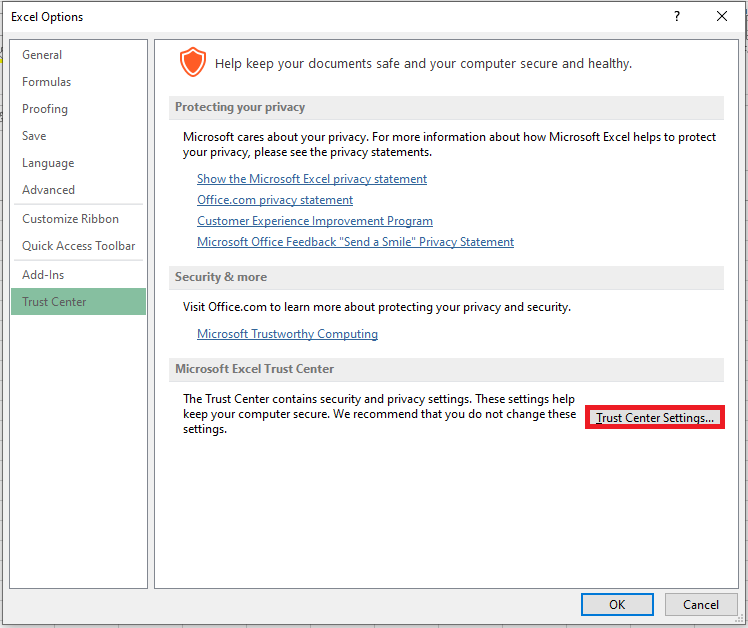
- In the window that pops-up, choose Protected View from the left side navigation. Under ‘Protected View’, uncheck all the checkboxes, and then hit OK.
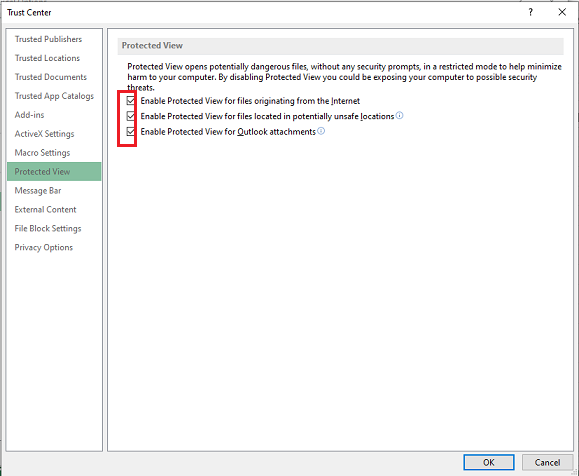
Now, try opening your corrupt Excel 2016 file. If it won’t open, try the next workaround.
Workaround 3 – Link to the Corrupt Excel File using External References
If you only need to extract Excel file data without formulas or calculated values, use external references to link to your corrupt Excel 2016 file. Here’s how you can do it:
- From your Excel file, click File > Open.
- From the window that opens, click Computer and then click Browse and copy the name of your corrupt Excel 2016 file. Click the Cancel button.
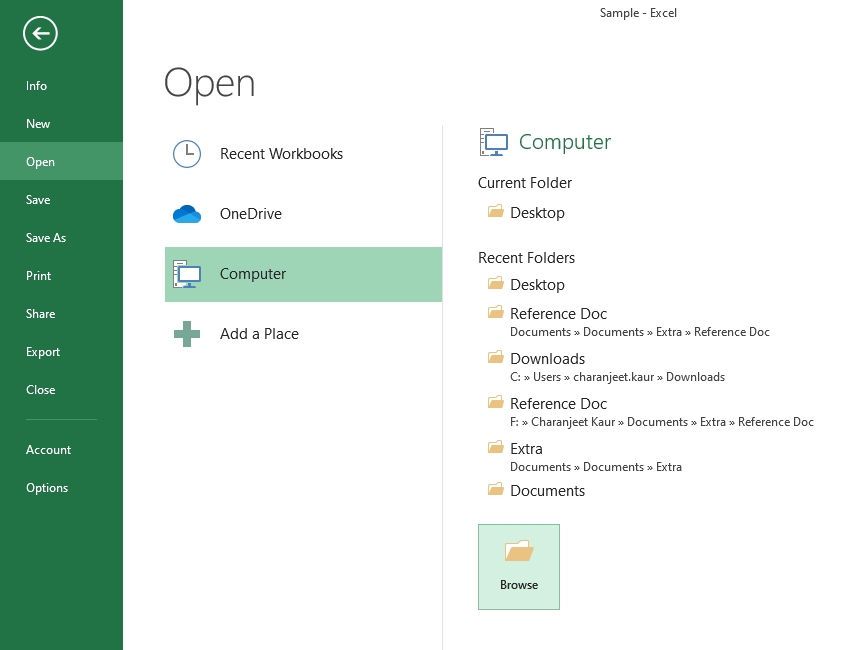
- Go back to your Excel file, click File > New > Blank workbook.
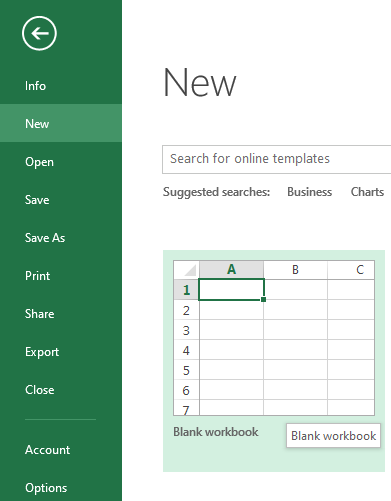
- In the new Excel workbook, type “=CorruptExcelFile Name!A1” in cell A1 to reference cell A1 of the corrupted file. Replace the ‘CorruptExcelFile Name’ with the name of the corrupt file that you have copied above. Hit ENTER.
- If ‘Update Values’ dialog box appears, select the corrupt 2016 Excel file, and then click OK.
- If ‘Select Sheet’ dialog box pops-up, select a corrupt sheet, and press the OK button.
- Select and drag cell A1 till the columns required to store the data of your corrupted Excel file.
- Next, copy row A and drag it down to the rows needed to save the file’s data.
- Select and copy the file’s data.
- From the Edit menu, choose the Paste Special option and then select Values. Click OK to paste values and remove the reference links to the corrupt file.
Check the new Excel file for recoverable data. If this didn’t work, consider using an Excel file repair tool to retrieve data.
Alternative Solution to Recover Excel File Data
Applying the above workarounds may take considerable time to recover corrupted Excel file 2016. Also, they may fail to extract data from a severely corrupted file. Using Stellar Repair for Excel software can help you overcome these limitations. The software helps repair severely corrupted XLS/XLSX file and retrieve all the file data in a few simple steps.
Key benefits of using Stellar Repair for Excel are as follows:
- Recovers tables, pivot tables, images, charts, chartsheets, hidden sheets, etc.
- Maintains original spreadsheet properties and cell formatting
- Batch repair multiple Excel XLS/XLSX files in a single go
- Supports MS Excel 2019, 2016, 2013, and previous versions
Check out this video to know how the Excel file repair tool from Stellar® works:
Conclusion
Errors such as ‘the file is corrupt and cannot be opened’, ‘Excel cannot open this file’, etc. indicate corruption in an Excel file. Large-sized workbook, virus infection, bad sectors on hard disk drive, etc. are some reasons that may result in Excel file corruption. The workarounds discussed in this article can help you recover corrupted Excel file 2016 data. However, manual methods can be time-consuming and might fail to extract data from severely corrupted workbook. A better alternative is to use Stellar Repair for Excel software that is purpose-built to repair and recover data from damaged or corrupted Excel file.
How to Fix ‘Sharing Violation Error’ when Saving Excel?
Summary: You may encounter the sharing violation error in Excel when you repeatedly save changes in a workbook. The error can occur due to different reasons. In this blog, we will discuss the possible reasons behind this sharing violation error and some effective solutions to fix it. If the issue has occurred due to corruption in Excel file, you can try the advanced Excel repair tool mentioned in the post to repair the corrupted file.
It is not uncommon to encounter errors while working with Excel application. One common error that Excel users face is the sharing violation error that occurs while saving an Excel spreadsheet. The complete error message says, “Your changes could not be saved to file because of a sharing violation.” When this error occurs, users won’t be able to save the changes in the file. So, it is important to fix this issue as soon as possible. But before fixing the error, let’s find out the causes behind this error.
Causes of Excel Sharing Violation Error
This error may pop up due to the below reasons:
- The file you are trying to save is corrupted.
- The Excel file is not in the trusted location.
- Sharing Wizard is disabled.
- You do not have permission to modify the Excel file.
- The Excel file is not permitted to get indexed.
Methods to Fix the Sharing Violation Error in Excel
You can move the affected Excel file to a new folder and save it with a different name. Then, see if it fixes the error. If it doesn’t help, you can try the below methods.
Method 1: Check and Change the Excel File Properties
You can get the sharing violation error in Excel if the file attribute options, such as “File is ready for archiving” and “Allow this file to have contents indexed in addition to file properties” are disabled. You can check the File Properties and enable these options to fix the issue. Here are the steps:
- Right-click on any Excel file and select Properties.

- In the Properties window, click on the Advanced option.

- In the Advanced Attributes window, select the below options under File attributes:
- File is ready for archiving.
- Allow this file to have contents indexed in addition to file properties.

- Click OK.
Note: If these options are already selected, then unselect and re-select them.
Method 2: Enable Sharing Wizard Option
The error “Your changes could not be saved to file because of a sharing violation” can also occur if the sharing wizard option is disabled on your system. You can check and enable the sharing wizard option using these steps:
- Go to your system’s Documents folder.
- Click View > Options > Change folders and search options.

- In the Folder Options window, click View.

- Under the View section, search for the “Use Sharing Wizard” option in the Advanced Settings.

- If the Use Sharing Wizard option is unselected, select it and then click OK.
Method 3: Move the Excel File to a Trusted Location
You can encounter the sharing violation error if the file you are trying to save is not in the trusted location. You can try moving the file to a trusted location by following these steps:
- In Excel, go to File and then click Options.
- Click Trust Center and then click Trust Center Settings.

- In the Trust Center window, click Trusted Locations and then click Add new location.

- In the Add new location window, select Browse to locate and choose the folder, and then click OK.
Method 4: Open Excel in Safe Mode
Incompatible add-ins can create issues in the Excel file. To check if the sharing violation issue has occurred due to add-ins, open Excel in safe mode. To do so, follow these steps:
- Open the Run window using Windows + R.

- Type excel /safe and click on OK.
- Open the affected file and then try to save the changes.
- If you are able to save the changes without any error, then it indicates add-ins are causing the issue. To fix this, you can remove the recently downloaded add-ins (if any).
Method 5: Repair the Excel File
Corruption in Excel file can also create issue while saving the changes. In such a case, you can repair the corrupted Excel file using the inbuilt utility in Excel, named Open and Repair. Follow these steps to use this utility:
- In Excel, navigate to File > Open > Browse.
- In the Open dialog box, click on the affected Excel file.
- Click the arrow next to the Open button and select Open and Repair from the dropdown.
- Click on the Repair option to recover as much data from the file as possible.
If the above utility fails to fix the corrupt Excel file, then you can use a more powerful Excel repair tool , such as Stellar Repair for Excel. This Excel repair tool can repair even severely corrupted or damaged Excel files (xls, .xlsx, .xltm, .xltx, and .xlsm). This tool can recover all the data from the corrupted Excel file, including images, chart sheets, formulas, etc., without changing the original format. It can help in fixing common corruption-related errors in Excel. You can download the software’s demo version to scan the corrupt file.
To Conclude
Above, we have discussed some effective methods to fix the sharing violation error in Excel. This error may also occur if you try to save the Excel file in an incompatible format. So, check the format and try saving the file in a compatible format. If the error occurs due to Excel file corruption, you can repair corrupt Excel file using the Open and Repair tool. If nothing works, then download a third-party Excel repair tool, such as Stellar Repair for Excel. It is an advanced tool that can fix severely corrupted Excel files. You can install this repair tool on any Windows system.
File Format and Extension of [filename] don’t Match in Excel File
Summary: The “File format and extension of [filename] don’t match. The file could be corrupted or unsafe” error message indicates that the Excel file you’re trying to open is unsupported, unsafe, or corrupted. Read this article to learn more about this error and how to fix this error. It also mentions an advanced Excel recovery tool to repair the corrupted Excel file and retrieve all its data in a few clicks.
You can encounter the “File format and extension of [filename] don’t match. The file could be corrupted or unsafe” error when the Excel application detects any issue with the file. This happens when you try to open an old version file format in a newer version or if the file is received from an unsafe destination. This can prevent you from opening the Excel file.
As indicated from the error message, this error occurs due to the following reasons:
- The file has incorrect file extension.
- The file is corrupted.
- The file you are trying to open is protected.
Now, let’s see how to resolve this Excel error.
Methods to Fix the “File format and extension of [filename] don’t match” Error
Try the following methods to troubleshoot the “File format and extension don’t match” error in Excel.
Method 1: Rename the Excel File
You can face the “File format and extension don’t match” issue if the file has incorrect extension. It can occur if the file extension has been altered or you’ve mistakenly saved the file with incorrect extension. To fix this, you can try renaming the Excel file with the correct file extension.
Method 2: Check the Default Excel File Format
Different versions of Microsoft Excel use different default file formats. For example, .xls is the default file format of older versions (2003 and lower) of Excel, whereas .xlsx format is used by the newer versions (2007 and later). Opening the Excel file with an incompatible extension can cause the “File format and extension don’t match” issue. You can check the Excel version you are using and ensure it’s compatible with the Excel file you are trying to open.
Method 3: Change the Protected View Settings
You may receive the “File format and extension of excel don’t match” error if the Excel file is protected. You can check and try disabling the Protected View settings .
Caution: Changing the Protected View settings can put your system at risk. If the Excel file is being downloaded from the internet, it may contain viruses that can infect your system. So be careful before disabling the Protected View settings.
Steps to Change Protected View Settings in Excel:
- In the Excel’s File menu, click on Options.
- Select Trust Center > Trust Center Settings.

- Under Trust Center, select Protected View and disable the below three options:
- Enable Protected View for files originating from the internet.
- Enable Protected View for files located in potentially unsafe locations.
- Enable Protected View for Outlook attachments.

- Click OK. Then, try to open the Excel file.
Method 4: Check and Provide the Excel File Permissions
Sometimes, you can get the error if you don’t have sufficient permissions to open the Excel file. This usually happens when you try to open the Excel file received from other sources. You can check and provide the desired permissions to fix the error. Here are the steps:
- Locate the affected Excel file, right-click on it, and select Properties.

- In the Properties window, click the Securities option and select Edit.

- In the Security window, under ‘Group or users name’, select the user names. Check the file permissions and make sure Full Control is enabled. If not, then click on the Add option.

- Click on the Advanced option in the Users, Computers, Service Accounts, or Groups window**.**

- Click the Find Now option. A list of all users and groups appears in the search field.

- Select “Everyone” from the list and then click OK.
- In the object names field, you will see ‘Everyone’. Click on OK.

- In the Permissions window, select “Everyone” and enable all options (Full Control, Modify, Read & Execute, Read, and Write) under Permissions for Everyone.

- Click Apply and then OK.
Method 4: Repair your Excel File
As the error message indicates, corruption is one of the causes of the “File format and extension of [filename] don’t match” error. If your file is corrupted, you can repair it using Microsoft’s built-in Open and Repair tool. Here are the steps to run the Open and Repair tool to repair corrupted Excel file:
- In Excel, click on File.
- Click Open and then click on Browse to select the corrupted Excel file.
- In the Open dialog box, click the Excel workbook (in which you are facing the error).
- Click the arrow next to the Open button and select Open and Repair.
- Then, click Repair to recover as much data as possible.
- The Excel prompts a message after the repair process is complete. Click Close.
The Open and Repair utility may fail to give the intended results. In such a case, you can repair the corrupted/damaged Excel file using a specialized Excel repair tool . Stellar Repair for Excel is one such tool that can repair severely corrupted Excel files. With the help of this tool, you can quickly recover all the objects from the Excel file. The tool has a simple user interface that even a non-technical can use to repair the Excel files. The tool can also repair multiple Excel files at once. You can check the tool’s functionality by downloading its demo version.
Closure
You can encounter the “File format and extension of [filename] don’t match” error due to different reasons. To resolve the issue, you can check the file extension, permissions, protected settings, etc. If you suspect the error has occurred due to corruption in the Excel file, you can try repairing the Excel file using the Open and Repair tool. If nothing works for you, then try Stellar Repair for Excel . It can repair highly damaged Excel files and recover all the data while preserving the file properties and cell formatting. The tool can help you fix all the common corruption-related errors quickly.
How to Fix “Errors were detected while saving Excel” Error?
When trying to save the Excel file, you might face unexpected errors. The “Errors were detected while saving Excel” is one such error. It can also occur when using VBA in Excel. The complete error message appears as:
**“Errors were detected while saving [file name]. Microsoft Excel may be able to save the file by removing or repairing some features. To make the repairs in a new file, click Continue. To cancel saving the file, click Cancel.”
**
The error can occur if the features (Pivot tables, charts, macros) used in the Excel file get corrupted . However, there could be several other reasons behind the occurrence of the error. Let’s discuss them.
What Causes the “Errors were detected while saving Excel” Error?
There are various reasons why you encounter this error. Here are some of them:
- Incompatible pivot table in the Excel file
- Large or uncompressed images in the Excel file
- File-sharing properties are not allowing file saving
- Excel file is corrupted
- Large-sized Excel file
- File version incompatibility
- VBA code is corrupted
Ways to Fix the “Errors were detected while saving Excel” Error
You’re not able to save the Excel file if there is no storage space on your hard drive. So, first check if your hard drive has sufficient storage space to save the file. If this is not the case, then it might happen that your antivirus program is interrupting the saving process. To check this, temporarily disable your antivirus program and then try to save the file. If still your Excel is throwing the “Errors were detected while saving Excel” error, then follow the below given methods to fix the error:
Method 1: Open the Excel in Safe Mode and Disable the Add-ins
When you open Excel in safe mode, it opens without the third-party add-ins. This helps in finding out if any add-ins are causing the error.
Here’s how to open the Excel in safe mode:
Open the Run window by pressing Windows key + R.
Type excel /safe in the Run window.
 ?
?Next, click on OK.
It will open Excel in safe mode.
Now, try to open and save the affected file.
If you are able to save the file without any issue, then this means that the error has occurred due to third-party add-ins or settings. You can try disabling the add-ins to fix the issue. To do this, follow these steps:
- First, open Excel.
- Then, go to the File tab and click Options.

- In Excel Options, click on the Add-ins
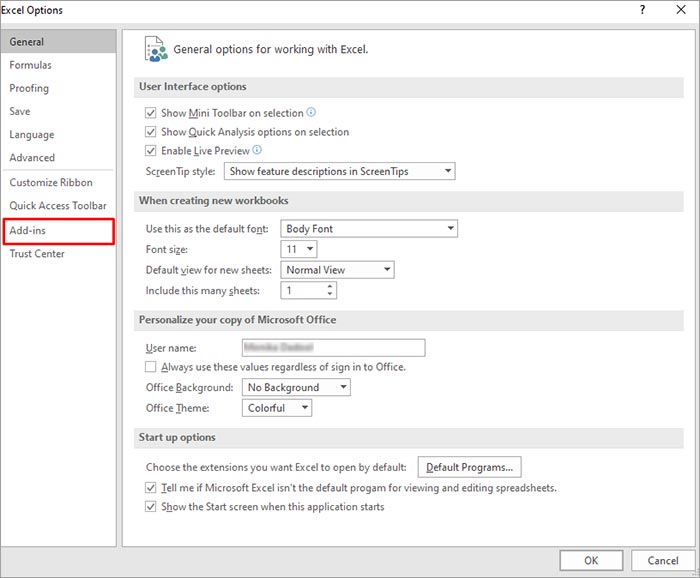
- Under the Manage section, select Excel Add-ins and then click on the Go
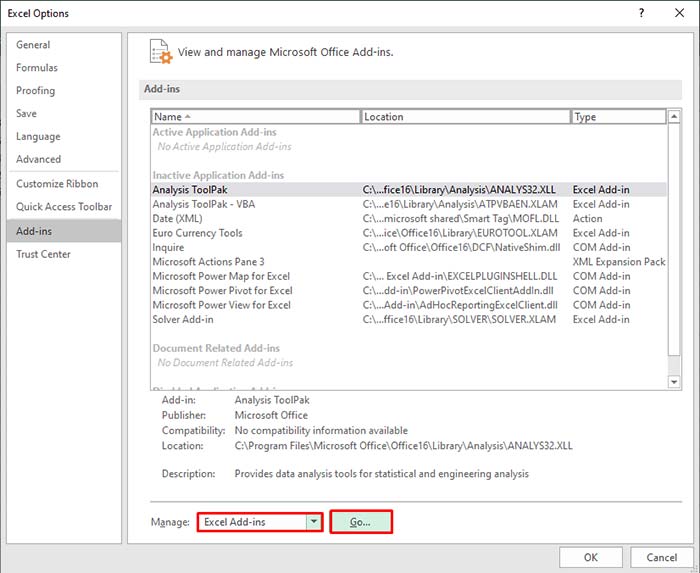
In the Add-ins dialog box, unselect the add-ins under the Add-ins available option and click OK.

Note: Disabling add-ins does not remove them from the system. To remove them permanently, you need to uninstall them.
Method 2: Check the Excel File Name
Some users have observed this error when saving the Excel file with an invalid name. You can check the file name and ensure that it should not contain more than 218 characters. If the name exceeds the required limit, then try shortening the file name or move the file to a folder with a short path name.
Method 3: Copy the Data from the Affected File to a New File
If you are not able to save the Excel document, then try copying the data from the affected file to a new Excel file. Then, save the new file with a different name. This helps in resolving the issue.
Method 4: Check and Provide File Permissions
You may experience the “Errors were detected while saving Excel” issue when you do not have desired permissions to modify the folder in which your Excel file is located. To modify the folder, you should have read, write, and create permissions. You can check and provide the desired permissions using the below steps:
- Navigate to the Windows Program Files and then find the desired folder (where the Excel file is saved).
- Right-click on the folder and then choose Properties.
- Select the Security tab and then click
- Click on Change Permissions in the Advanced Settings
- Click Administrators and then click Edit.
- Now set the Apply to drop-down button to This Folder, Subfolder, and Files.
- Click on the Full Control field and then click Apply > OK.
Method 5: Check Pivot Tables in Excel Sheet
You can review Pivot tables to see if they are causing the “Errors were detected while saving Excel” error. To do so, follow the below steps:
- Click Power Pivot > Manage.
- Check the tabs in the Power Pivot
- Check if all the formulas used in the table are correct. Sometimes, even a small typo can create an issue in Excel.
Method 6: Repair Your Excel File
The “Errors were detected while saving Excel” issue can also occur if the Excel file is corrupted. In such a case, you can take the help of the built-in utility in Excel – Open and Repair to repair your Excel file. Here’s how to use the tool:
- In Excel, click the File tab and then click Open.
- Click Browse to select the desired file.
- The Open dialog box is displayed. Click on the corrupted file.
- Click on the arrow next to the Open button and then click Open and Repair.
- Click on the Repair

- After repair, a message will appear (as shown in the below figure).
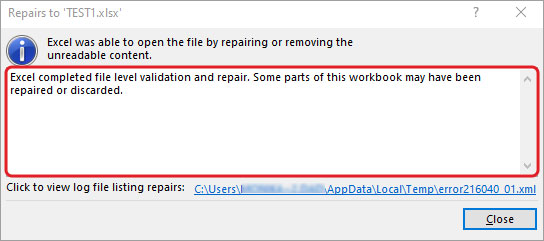
- Click Close.
However, sometimes, the Open and Repair utility fails to fix the file if it is severely corrupted or large-sized. In such a case, you can take the help of a third-party Excel repair software, such as Stellar Repair for Excel. The tool performs a comprehensive scan of the corrupted Excel file to fix the issues and recover all the items from the file without changing the original formatting. It can recover pivot tables, charts, images, engineering formulas, etc. The tool is compatible with Windows 11/10/8.1/8/7. You can download the free trial version of the tool to evaluate its functionality.
Closure
Many Excel users reported facing the situation when they are saving the Excel file. You can check the file’s compatibility to fix the “Errors were detected while saving Excel” issue. If you are getting this error in a Macro-enabled file then you can try deleting the VBA project from a document to resolve the issue. However, deleting the entire VBA code cannot be a better solution as it can lead a data loss in the Project you are working on. In the above article, you have learned the reasons behind the issue and discovered how to fix the error. Follow the methods and if none of them works then try using Stellar Repair for Excel. It is an advanced tool that can quickly repair corruption in Excel worksheets at any level. It lets you restore the corrupted components from the corrupted file without removing the existing data.
- Title: Recover Permanently Deleted or Erased Excel 2007 Files for Free | Stellar
- Author: Vivienne
- Created at : 2024-07-17 04:48:59
- Updated at : 2024-07-18 04:48:59
- Link: https://review-topics.techidaily.com/recover-permanently-deleted-or-erased-excel-2007-files-for-free-stellar-by-stellar-guide/
- License: This work is licensed under CC BY-NC-SA 4.0.












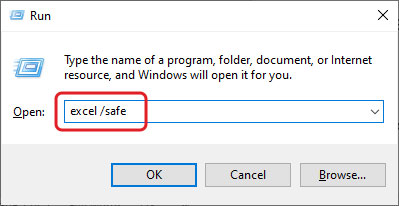 ?
?
